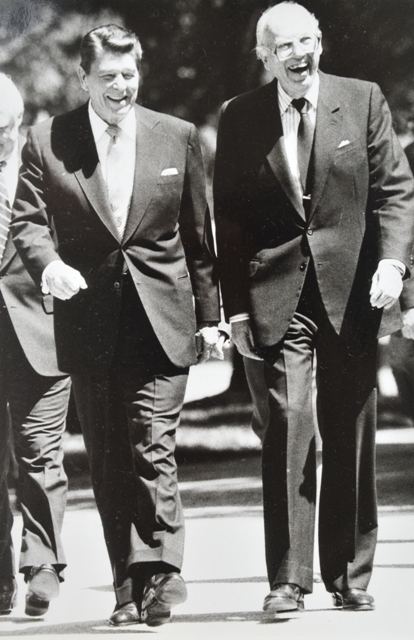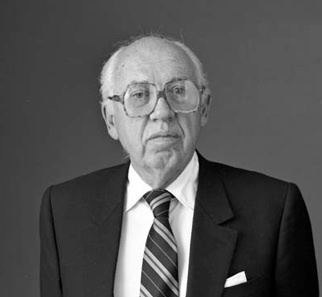Name William Casey | Religion Roman Catholic | |
 | ||
Born March 13, 1913Elmhurst, Queens, New York ( 1913-03-13 ) Books The secret war against Hitler, Where and how the war was fought, Accounting desk book Organizations founded Manhattan Institute for Policy Research, The Jamestown Foundation | ||
William J. Casey: Intelligence Stalwart
William Joseph "Bill" Casey (March 13, 1913 – May 6, 1987) was the Director of Central Intelligence from 1981 to 1987. In this capacity he oversaw the entire United States Intelligence Community and personally directed the Central Intelligence Agency (CIA).
Contents
- William J Casey Intelligence Stalwart
- William j casey the status of us intelligence in the us today ashbrook center 8 27 1986
- Life and career
- Director of Central Intelligence
- IranContra affair
- Personal life
- Death
- References

William j casey the status of us intelligence in the us today ashbrook center 8 27 1986
Life and career

A native of Elmhurst, Queens, New York, Casey graduated from Fordham University in 1934. He did graduate work at the Catholic University of America before earning an LL.B. from St. John's University School of Law in 1937. Following his admission to the bar, he was a partner in the New York-based Buckner, Casey, Doran and Siegel from 1938 to 1942. Concurrently, as chairman of the board of editors of the Research Institute of America (1938–1949), Casey initially conceptualized the tax shelter and "explained to businessmen how little they need[ed] to do in order to stay on the right side of New Deal regulatory legislation."

During World War II, he worked for the Office of Strategic Services (OSS)—the predecessor to the CIA—where he became head of its Secret Intelligence Branch in Europe. He served in the United States Naval Reserve until December 1944 before remaining in his OSS position as a civilian until his resignation in September 1945; as an officer, he attained the rank of lieutenant and was awarded the Bronze Star Medal for meritorious achievement.

Following the dissolution of the OSS in September 1945, Casey returned to his legal and business ventures. After serving as a special counsel to the United States Senate (1947–1948) and associate general counsel to the Point Four Program (1948), Casey founded the Institute for Business Planning in 1950; there, he amassed much of his early wealth (compounded by investments) by writing several data-driven publications on business law. He was a lecturer in tax law at the New York University School of Law from 1948 to 1962. From 1957 to 1971, he was a partner at Hall, Casey, Dickler & Howley, a New York corporate law firm, under the auspices of founding partner Leonard W. Hall. He ran as a Republican for New York's 3rd congressional district in 1966, but was defeated in the primary by former Congressman Steven Derounian.

He served in the Nixon Administration as the chairman of the Securities and Exchange Commission from 1971 to 1973; this position led to his being called as a prosecution witness against former Attorney General John N. Mitchell and former Commerce Secretary Maurice Stans in an influence-peddling case stemming from international financier Robert Vesco's $200,000 contribution to the Nixon reelection campaign. He then served as Under Secretary of State for Economic Affairs (1973-1974) and chairman of the Export-Import Bank of the United States (1974–1976). During this era, he was also a member of the President's Foreign Intelligence Advisory Board (1975–1976) and of counsel to Rogers & Wells (1976–1981). He was a co-founder of the Manhattan Institute in 1978. He is the father-in-law of Owen Smith, Chairman of the Board of Trustees of the Institute of World Politics and Professor Emeritus at Long Island University.
Director of Central Intelligence

As campaign manager of Ronald Reagan's successful presidential campaign in 1980, Casey helped to broker Reagan's unlikely alliance with vice presidential nominee George H.W. Bush. He then served on the transition team following the election. After Reagan took office, Reagan named Casey to the post of Director of Central Intelligence. Outgoing Director Stansfield Turner characterized the appointment as the "Resurrection of Wild Bill," referring to Bill Donovan, the brilliant and eccentric head of OSS in World War II whom Casey greatly admired. Despite Casey's provenance in the Intelligence Community, the position was not his first choice; according to Rhoda Koenig, he only agreed to take the appointment after being assured that "he could have a hand in shaping foreign policy rather than simply reporting the data on which it was based."

Ronald Reagan used prominent Catholics in his government to brief the pope during the Cold War. Casey would fly secretly to Rome in a windowless C-141 black jet and "be taken undercover to the Vatican.
Casey oversaw the re-expansion of the Intelligence Community to funding and human resource levels greater than those existing before the preceding Carter Administration; in particular, he increased levels within the CIA. During his tenure, post-Watergate and Church Committee restrictions were controversially lifted on the use of the CIA to directly and covertly influence the internal and foreign affairs of countries relevant to American policy.
This period of the Cold War saw an increase in the Agency's global, anti-Soviet activities, which is started under the Carter Doctrine in late 1980.
Iran–Contra affair
The day before Casey was scheduled to testify before Congress related to his knowledge of the Iran–Contra affair, Casey suffered two seizures and was hospitalized. Three days later, Casey underwent surgery for a previously undiagnosed brain tumor.
In a 1987 book, Veil: The Secret Wars of the CIA 1981–1987, Washington Post reporter and biographer Bob Woodward, who had interviewed Casey on a number of occasions for the biography, said that he had gained entry into Casey's hospital room for a final, four-minute encounter—a claim which was met with disbelief in many quarters as well as an adamant denial from Casey's wife, Sofia. According to Woodward, when Casey was asked if he knew about the diversion of funds to the Nicaraguan Contras, "His head jerked up hard. He stared, and finally nodded yes." Independent Counsel, Lawrence Walsh wrote: "Independent Counsel obtained no documentary evidence showing Casey knew about or approved the diversion. The only direct testimony linking Casey to early knowledge of the diversion came from [Oliver] North."
Personal life
Casey, a Catholic, was a member of the Knights of Malta.
Death
Casey died of a brain tumor on May 6, 1987 at the age of 74. His Requiem Mass was said by Fr. Daniel Fagan, then pastor of St. Mary's Roman Catholic Church in Roslyn, New York. It was attended by President Reagan and the First Lady. Casey is buried in the Cemetery of the Holy Rood in Westbury, New York. He was survived by his wife, the former Sophia Kurz (d.2000), and his daughter, Bernadette Casey Smith.
